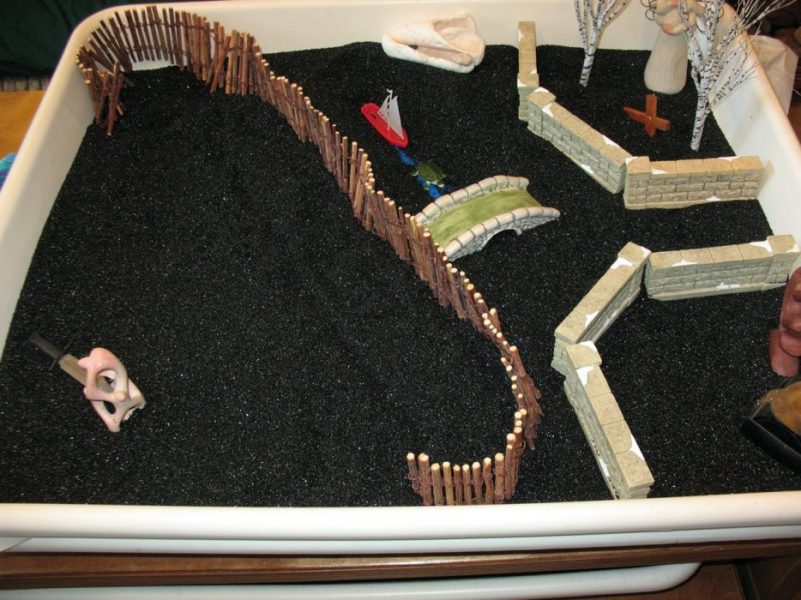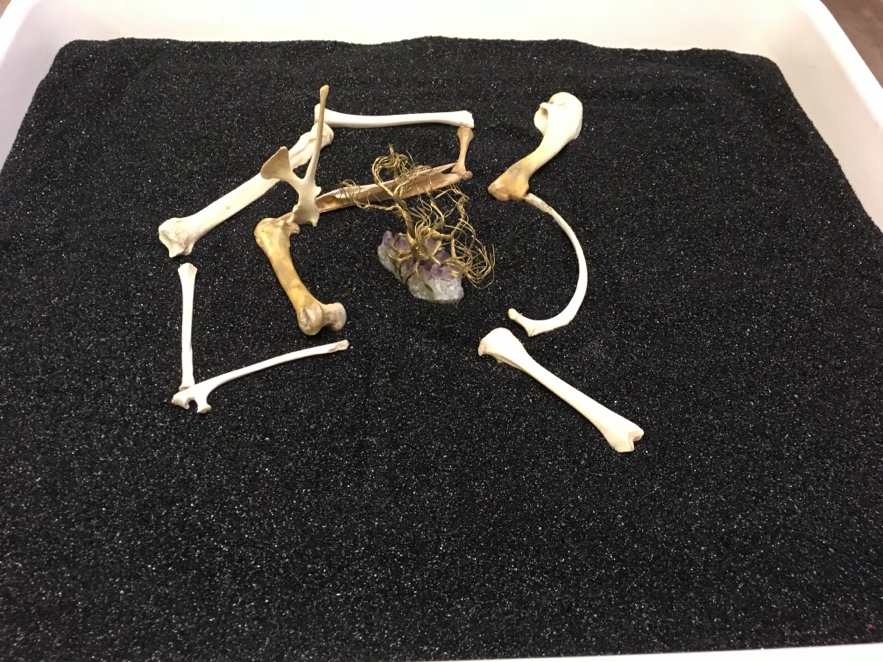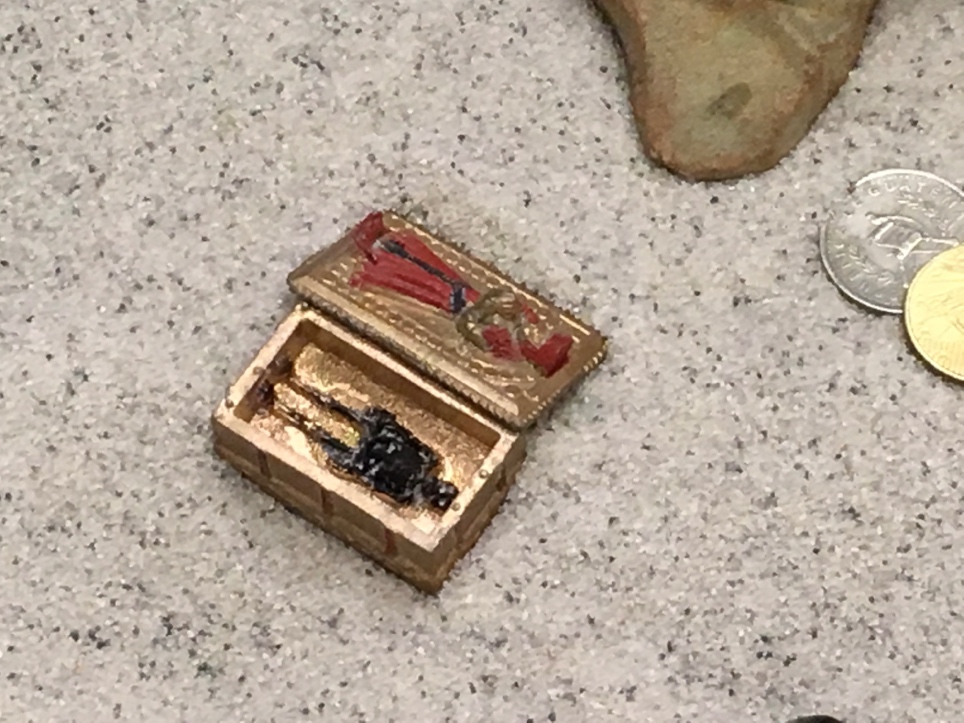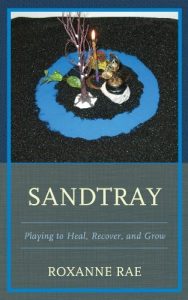Today I am sharing my experience with a woman in her early 20’s. I am calling her April. I’ve chosen to present this material to demonstrate several points:
- How a “talk therapist” can use a Sandtray consultation to create further access to a client’s internal processes, to be used for their future efforts in treatment.
- The power of image thinking to illuminate a healing path when a person feels “stuck” in a habitual trauma narrative.
- The value of just a single Sandtray session.
- How using expressive arts to access the right-brain can produce a profound shift in perspective.
Most of techniques used here to connect April to her experiences are applicable to drawing, painting. clay, dance, and other artistic modalities.
Requesting a Sandtray session “to see what it’s like,” April provided no presenting problem or issue. She came from out of town, and once we were face-to-face became willing to share some history. April was in verbal therapy and feeling that she was “stuck.” She began living with a relative as a teen because she and her mom fought extensively. Their family rules included: “Don’t trust anyone, and no crying or expressing negative emotions.” She denied any history of substance abuse in her family. Her current caregivers supported her emotionally and they provided funds for her therapy.
In the third grade April was diagnosed with learning disorders which have made expressing herself in words difficult. She required a sleep-apnea machine and suffered from fibromyalgia. She also had a debilitating autoimmune disorder that manifested during her late teens. On careful questioning she revealed that she was recently diagnosed with Bipolar I, mild-severe, rapid cycling with no psychosis, and was on more than 20 medications. Just prior to starting her tray she shared that she had been molested at age 14, and raped at age 18.
In the process notes below, my personal reactions will be noted in brackets. April’s comments are in quotes. This presentation covers the main portion of our session. For those unfamiliar with my work, I use the terms Witness and Creator for the roles of therapist and client.
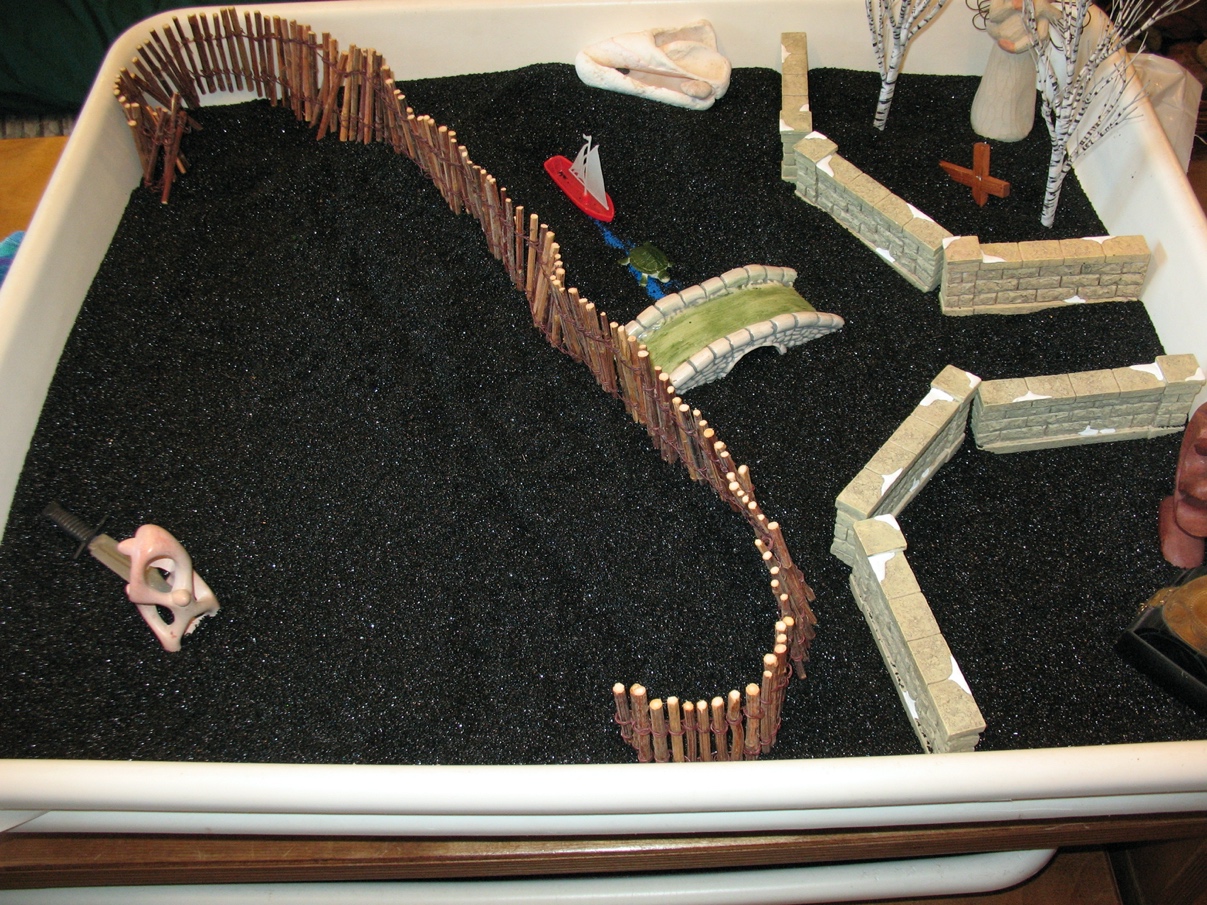
April chose black sand, then her objects, and created her tray primarily in silence, often standing up. At the beginning I could feel her muster herself to participate in a process which was quite foreign to her linear thinking. During the formation of this world she appeared contemplative. In the Witness’s position across from her, I paid acute attention and took notes of the placement of objects with an accepting stance. April’s first items were two birch trees, and she whispered “peace.” Then she added a soapstone tower of people, and a knife placed inside this tower [These last two items were physically close to me and I felt a startle when she placed the knife.] April then placed the angel holding a child near the trees, and the bridge more to center. Next, the wooden fence came in and she adjusted it to make the knife side bigger, adjusting the bridge. Then she formed the blue “water,” and placed the turtle facing the bridge. The treasure box, sun-bleached conch shell, and the “moon-person” came next, adding the stone walls around them last. April made some adjustments to her “peace” area, asking for a wooden cross which she placed between the birch trees to connect them. She then added walls around there too. Lastly, a sailboat is set near the turtle (figures 1 & 2). When I invited her to look at her world silently for a few moments and just notice what came up for her she was able to do so.
Beginning the Reflecting/Directing aspect of her session, April again adjusted the wooden fence toward the “peace” trees. This action created a larger enclosed space than she had initially formed for the people tower. She then stated, “There are a lot of walls here.” With each of my reflections she moved deeper into her experiences. Secondly she whispered, “It’s sad,” became quietly tearful, the energy of grief was strong [I also felt tears welling.] This sorrow shifted and her third revelation came, “There is fear here” (figure 3).
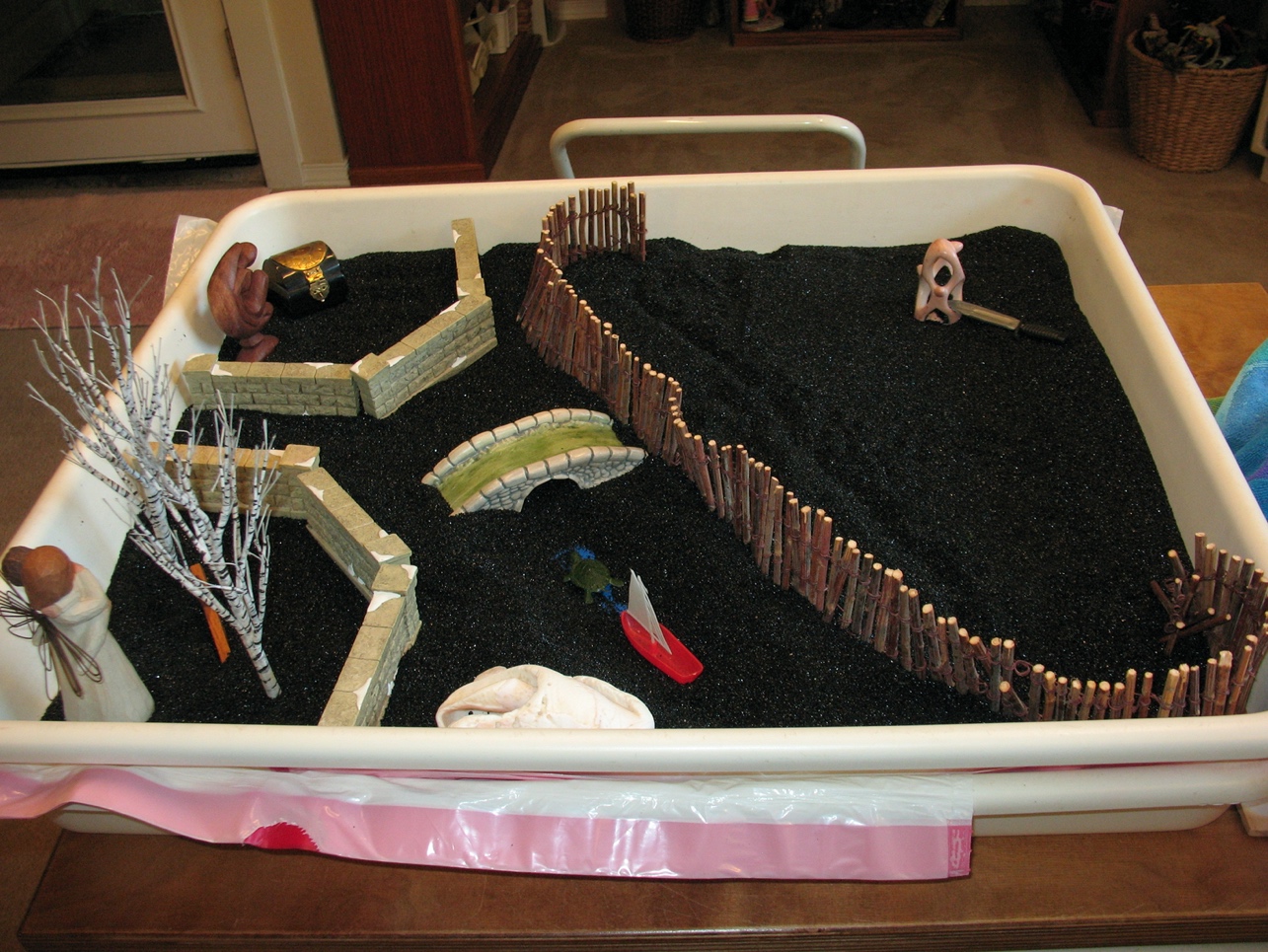
April was unable to offer more verbally, so we flowed into the aspects of Entering the World and Exploring from Inside the World. When engaging in these two aspects I move my chair to sit beside the Creator. This position seemed to help April feel more comfortable to be with her world, as she was able to find words more easily. Our exploration and dialogue elicited much more information about the experiences in her sand world:
- April began with the turtle. “This turtle is male and he is coming from the ocean outlet…the ocean is ancient and wise.” She described this turtle as slow, but that he is able to move when he pokes his head out. “The turtle is able to come and go, but he always stays close to the shore so that he can readily retreat…. He thinks he should go under the bridge to hide but he has hit his head on it in the past so he is cautious.” We are able to connect to a sense of “aliveness” that is deep inside the turtle and is in some way linked to his power.
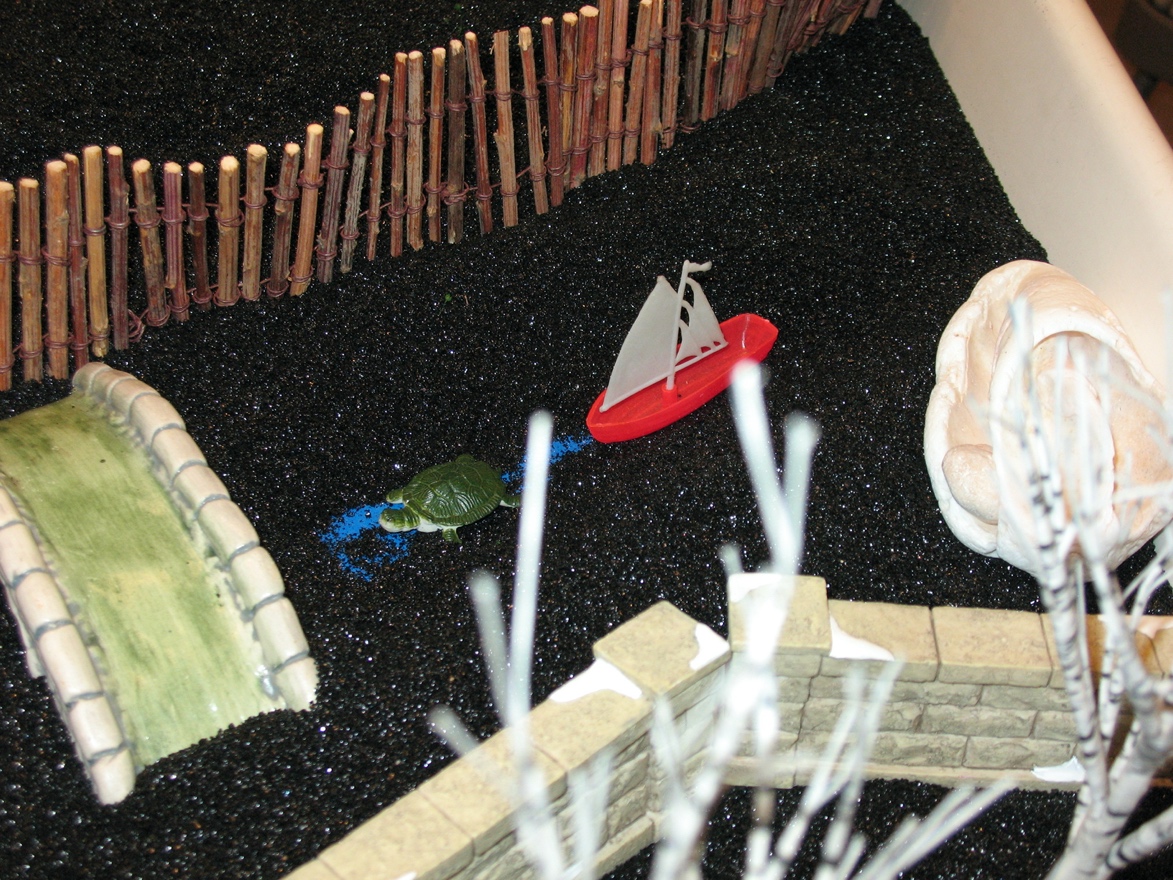
- We then moved in to view this world from the turtle’s perspective, using active imagination and becoming the turtle. “The treasure box is scary past secrets” (figure 5). As we continue, April realizes that there is a connection between the turtle and the wooden moon-person. “The moon-person wants to appear dead, like the dry wood she seems to be made of. When the turtle pokes his head out and looks around, this action wakes up the girl’s aliveness, but she must be wary as she fears the secrets in the box” (figure 6). At this point, April tries various positions for the turtle with micro-movements near his water area. We explore his perceptions from each position.
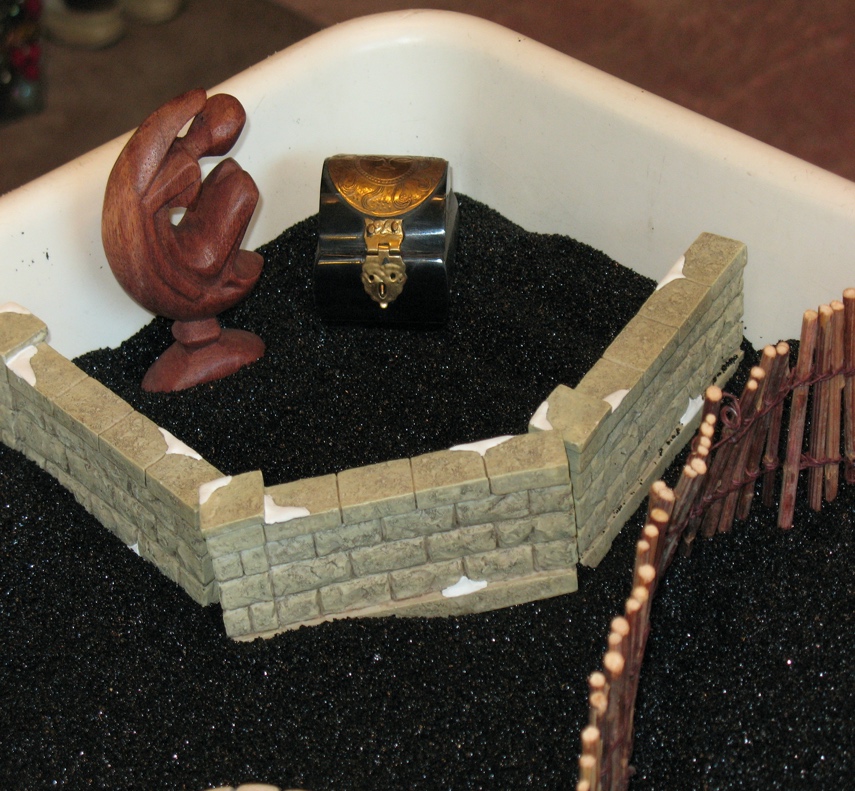
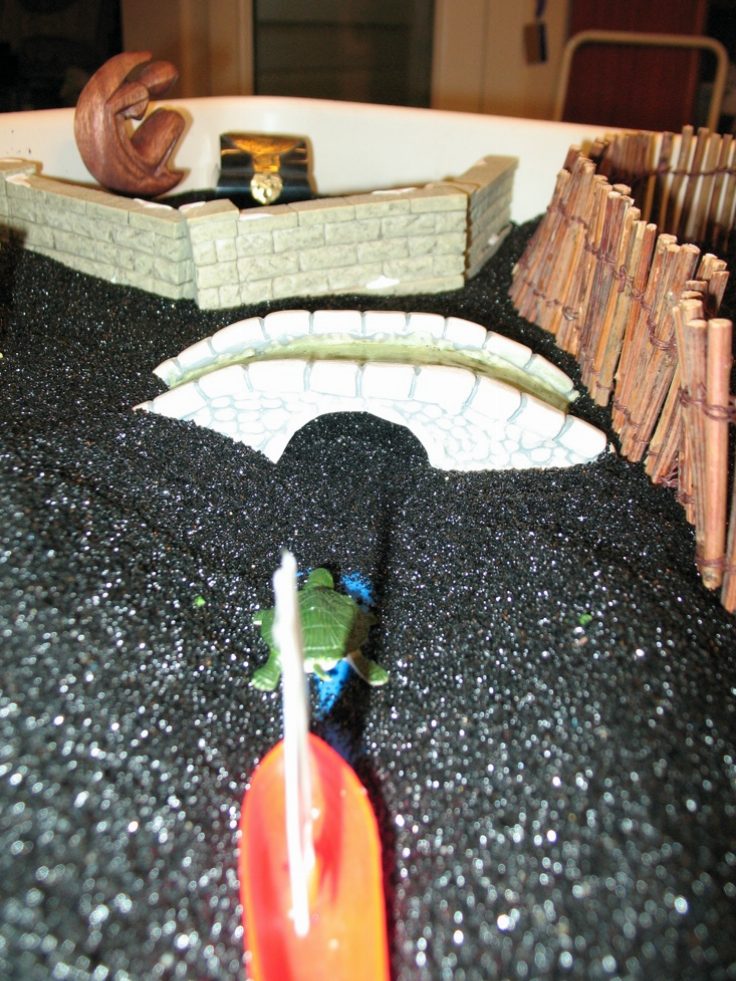
- Continuing to explore, April identifies that all of these areas feel “blocked off” to the turtle. She also noticed that the hole under the arch of the bridge is “not really open as it is full of sand.” We identify that “this is a place that the turtle thinks he should go but it doesn’t work like he expects.” He eventually discovers “that he could go around the bridge” (to the turtle’s left). She notices that the boat nearby seems “old and anchored” and appears to impede the turtle’s path to the ocean (figure 7).
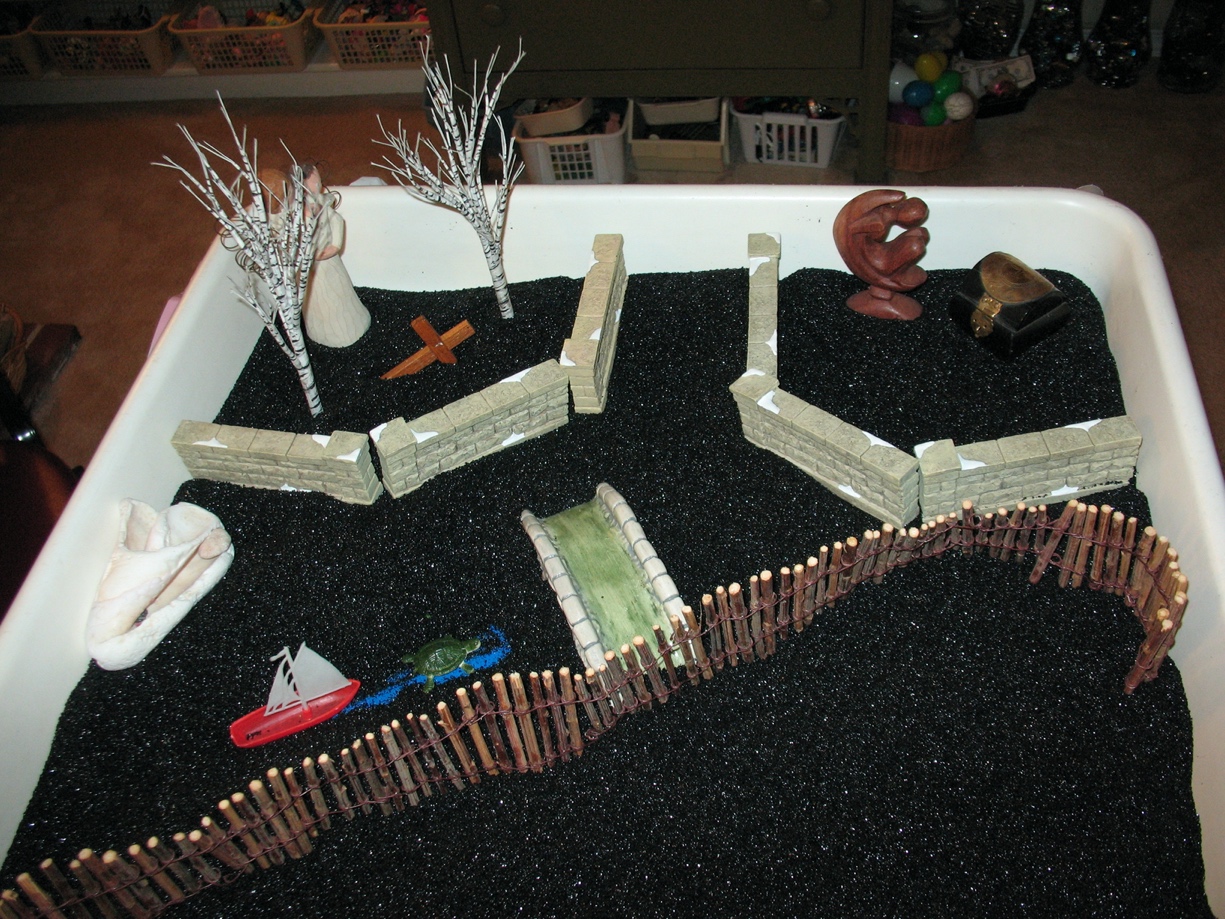
- Together we notice how big the wooden-fence area is that contains the tower of people and the knife, acknowledging that April chose to make this space bigger several times. She then moves her focus to explore the tree place (figure 8). First we notice how the wooden cross connects the “trees of peace.” We discover that the angel “holding up the child is connection and relationship.” April speaks about the stone walls as if they are very high, yet we observe that there may be ways that the turtle could communicate over these walls to either section. He “knows what’s on the other side.” He has already connected with the moon-person. The whole tree corner is “Peaceful and the turtle wants it very much” and we sit with this longing. “He is anxious about it as he fears wanting it too much. He has no faith that he will get it.” We again sit in silence simmering these experiences. “This place feels unattainable, that’s why it’s so sad.”
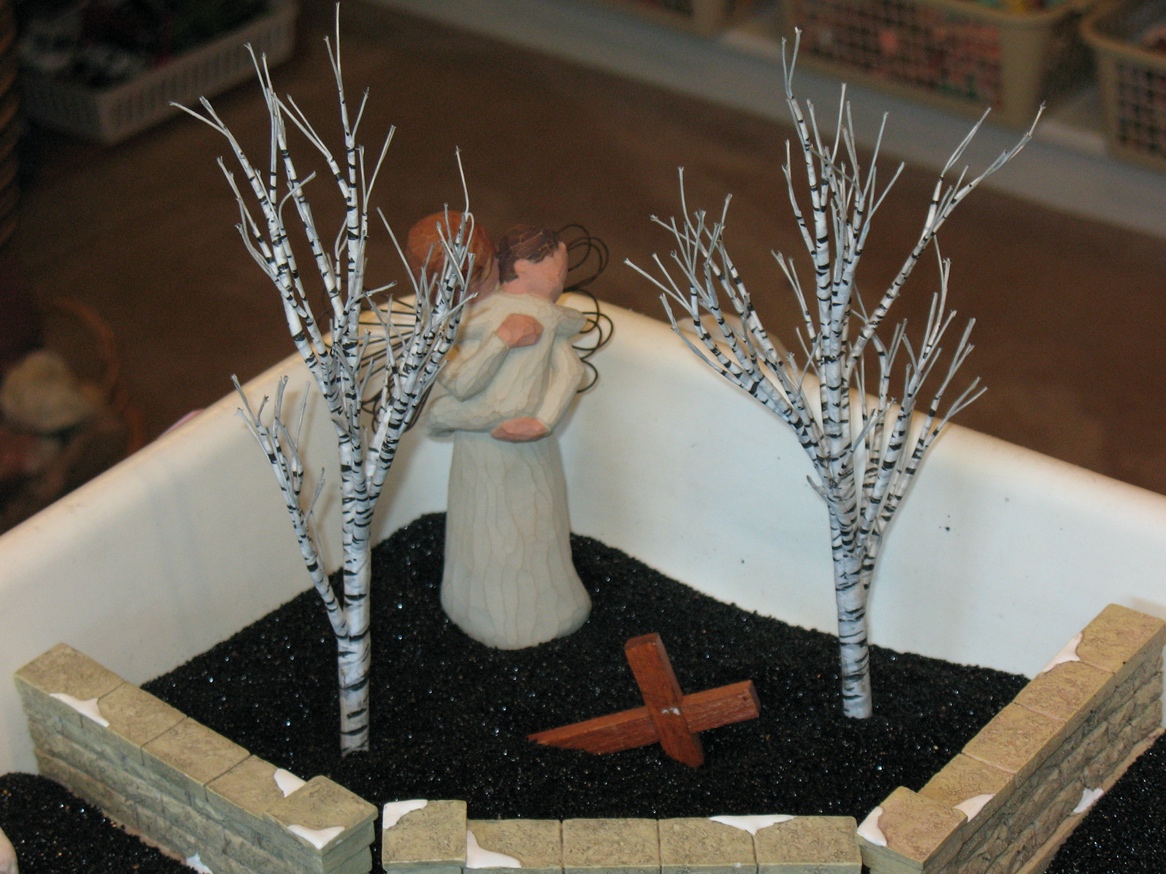
At the end of the session, we did a brief summary noting that April now had access to words for more of her experiences. A particular focus was that the turtle knows his aliveness and may communicate with areas previously believed to be blocked off, and that peace may not be unattainable since it can clearly be seen here [by the turtle and by us.] She was also able to sense aliveness within herself and begin to honor it. April asked if we could have contact about this session later. Since this was a single session consultation, and I was hopeful that this Sandtray experience might fit into her on going treatment, I agreed. One important note is that April subsequently confirmed that her rape was a gang rape, and that she had been held at knife point. This was the large area of the tray that we did not explore. She was not yet prepared to deal with that horrific trauma.
The next day, April shared how anxious she felt at first starting the Sandtray process… “Then I was in my element, my creative part was free to come out.” She sounded relieved and reported that, “It was incredible, I was finally able to put words to some things that I previously could not. Things I knew I felt but was unsure if they were real…Things I did not know were there and they came out (in the sand world) and it helped me remember.” She expressed that the Sandtray process “Helped me to remember that even with all the hard and bad things that happened, there is a little piece of heaven that I have to hold on to.”
At her request, I prepared some options for April’s future work with her current therapist. I include these here as they demonstrate the type of exploration I might do with a person in subsequent sessions using their Sandtray as a vehicle. I emphasized that these were not intellectual exercises but rather for dance, art or journaling based on using active imagination.
- What is it like for the turtle when he begins to become aware of the area with the trees? How does he respond with his thoughts, his body, and his feelings? What more does it mean to him? What does he believe others know about this place?
- What is it like for the turtle when the brown moon-person peeks out? How much is the turtle aware of the tiny bit of aliveness inside her? How do they impact each other? What might a conversation between them include? Can they support each other in any way?
- Become the turtle and from inside his experience discover: What does he need to notice, remember, attend to so that he is not overwhelmed by some of this world? What is his ability to tolerate being in this world and staying connected to his aliveness, what are his resources that help him? How can he learn about being here safely without retreating to the ocean so often?
With wonder, April expressed curiosity about this process and how it worked. “When I picked up objects and put them into the tray, I had no idea what I was making or why I put them where I did. Even when I was finished (making the tray), I was not sure what the pieces stood for. It was not until we started talking that I began to make connections, why is this? How could I create something so descriptive of the feelings and experiences inside me, yet not even know before hand?” I did spend time to explain this method of Sandtray to her. April’s wonder reflects the awe that I still feel when helping others or creating my own sand worlds.

